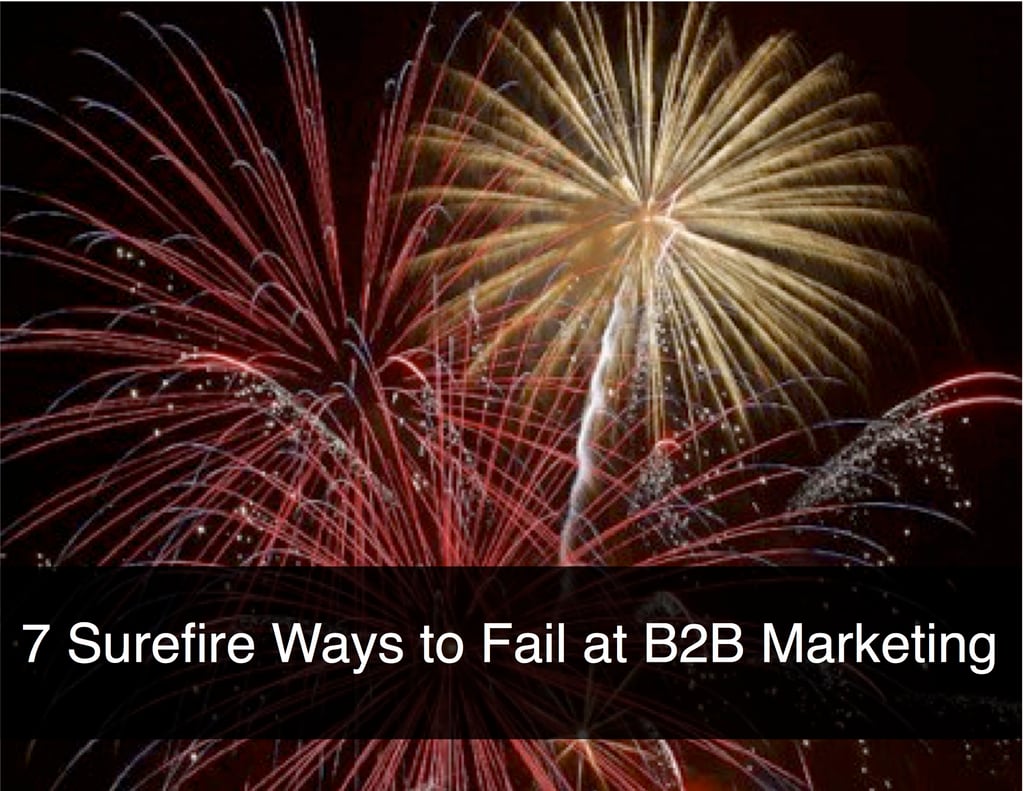 Much is written these days about the changing nature of B2B marketing. The internet and marketing automation are changing how companies engage customers. Social media is playing a prominent role in shaping customer choices and influencing new trends. Some call these changes “consumerization” of B2B marketing, a potentially game-changing environment for some B2B marketers.
Much is written these days about the changing nature of B2B marketing. The internet and marketing automation are changing how companies engage customers. Social media is playing a prominent role in shaping customer choices and influencing new trends. Some call these changes “consumerization” of B2B marketing, a potentially game-changing environment for some B2B marketers.
Our bet is that for many companies, efforts in these emerging areas will largely be wasted. Without a solid foundation of B2B marketing expertise, no amount of sizzle will improve the taste of the steak. It’s like trying to go to grad school before passing Marketing 101.
The Fast Track to Failure
What can companies do to shore up their foundations and take advantage of these emerging trends? For starters, they can compare their own efforts to these seven surefire ways to fail at B2B marketing. Be honest, if you recognize your company among these scenarios. The sooner you acknowledge these “deadly sins,” the sooner you can get on the path to redemption, building a real strategic marketing capability, enabling new thinking, and unlocking B2B marketing trends that succeed.
1. Engage in “S’Marketing”
When companies talk about Sales and Marketing as if they are part of the same function, you can bet that marketing is completely beholden to sales. One of our clients calls this “s’marketing” – a combination of the words “sales” and “marketing.” If this is how your marketing department operates, they are filling an important role, but it’s not marketing, it’s sales support.
Real B2B marketing is about understanding how your customers think and behave up and down the value chain. It’s knowing why they choose (or don’t choose) your offerings relative to their next best alternatives. This is a lot more important than ordering matching golf shirts for trade show staffers or selecting colors to represent your brand.
2. Use Consumer Marketing Frameworks
It’s tempting to borrow frameworks and analogues from business-to-consumer marketing (B2C), but this is often a mistake. B2B marketing is fundamentally different than consumer marketing, especially with regard to the purchase decision. In B2C marketing, much is made about positioning, which reduces your value proposition to the one thing you want customers to remember about your product. This is driven by the limitations of a 30-second commercial in which to deliver your message, and the typical 15-second purchase decision window in which the marketer has the opportunity to influence the customer. To state the obvious, this is not how B2B customers buy. Buyers generally evaluate multiple product attributes across multiple suppliers in a purchase process that can span weeks or even years.
An unfortunate manifestation of this approach occurs when B2B companies hire senior marketing leaders from major consumer products companies. In our experience, this almost never works. The cultures are too different, and the result is frequently akin to “organ rejection.” Someone with a classic consumer marketing background is probably used to having a massive marketing budget aimed at well-known retail channels. They may not have the time, patience or aptitude to understand the technical details of complex B2B channels and the respective purchasing dynamics.
3. Put Too Much Emphasis on Brand
Much like marketing frameworks, consumer branding is very different than business branding, and the two are not interchangeable. While brand recognition is certainly important in B2B marketing, what’s more important is your reputation with a customer based on their most recent experience with your company. If your brand means “the guys who over-promise and then deliver three weeks late,” no amount of research or map of your brand attributes and brand essence will fix that. In B2B, you need to focus on the reality of the value proposition you deliver, and the brand will follow.
A side note on consumer durables -- It’s tempting to think that brand plays a bigger role here because the end customer is a consumer. That’s not always the case. Here’s how I test the importance of branding. If a consumer can tell you the last brand they bought, then you can treat it as a consumer brand. Cars and major appliances are often clear-cut consumer brands, but I’d be surprised if you are able to tell me the brand of roofing shingles or electrical hardware you last bought. If you can, you either work in that industry or you bought them within the last 30 days.
4. Collect Data Instead of Insights
In many B2B marketing organizations, the emphasis is on tracking market share, researching competitive product launches, analyzing price changes, etc., and producing the requisite charts and reports to share this data. But what does this data mean, especially to the customer? If marketing doesn’t understand its implications, who does?
Our experience in consulting has shown us that all the analysis in the world is useless if you can’t answer two questions: “why?” and “so what?” Marketing should put this data to use drawing out the business implications, and helping refine both strategy and tactics.
5. Use Cost-Based Pricing
I shouldn’t have to say this, but it’s worth repeating: prices should be based on value to your customer, NOT your cost. It’s unfortunate that cost-based pricing is still way too common. For many, costs are easier to calculate than value, so cost-based pricing feels more certain. It also helps make the case for a new product where margins will be higher than other items in the product line. But cost-based pricing is never a substitute for understanding business value. As one of my colleagues once observed, “If your price is based on cost and you make the sale, all you know is that you priced too low. You just don’t know how much too low.”
6. Focus on the Wrong Customer
Good marketing strategy starts with understanding your customer, but who is the customer? Some B2B companies still view the channel customer instead of the end user as the primary focus, but this is often a mistake. For example, one of the reasons Honeywell, the leader in residential thermostats, was so surprised by Nest was because Honeywell focused primarily on professional contractors as their customer. Nest solves a problem for the homeowner in a completely unconventional way and because it was initially a DIY product, it effectively eliminated the contractor. In today’s world, if there’s a better solution for the end customer and you’re not working on it, you can almost bet that someone else is, and it may not be one of your traditional competitors!
7. View Marketing as a Department
Strategic marketing is a unique way of thinking, and it needs to be valued by executives and managers across functions. By viewing marketing as a department, marketing’s influence is limited. This reduces their impact on product innovation, and helping the company understand customer needs and their implications.
That said, it creates a false equivalence when marketing is one input among many rather than the lead input. This might seem fair, but no amount of supply chain management or operational efficiency will help for long if you’re not creating customer value. Strategic marketing is the lead capability for defining the direction of the business, and helping managers make the trade-offs between multiple goods.
The Road to B2B Marketing Success
Which road are you on? If you occasionally engage in one or two of the activities described above, it might be enough to just focus and root out the behavior. But for many, it’s necessary to start by defining what good B2B marketing looks like.
In our view, this starts with grounding all critical management decisions in an informed view of your market and customer needs up and down the value chain. Customer segments should be defined based on these needs, with clear value propositions developed for target market segments, and a clear definition of what you will NOT do.
There are then three key areas that usually need to be addressed for B2B marketing to improve and flourish, making it a true capability, not just a department:
-
Consciously invest in building marketing capabilities. People do not change overnight. If old habits have been around for awhile, it will take more than just training to change them. In our experience, frequent reinforcement of what “good” looks like and real project success examples can supplement skills training and accelerate culture change. You may also need to hire a few people to seed these new skills, but if you have never asked people to think this way before, a few of your existing people might surprise you given the right training and reinforcement.
-
Solidify leadership commitment to improving marketing capabilities. It should go without saying that if leadership is not “walking the talk,” a lot of good effort can go to waste. Ensuring leadership understands the key concepts and is not acting in ways that violate them is key. For example, if market research budgets are the first thing cut whenever making the quarter is at risk, this sends a strong signal about the real leadership priorities.
-
Align key business processes with the desired marketing changes. Often companies need to review all their marketing related processes (stage-gate, portfolio management, product management, strategic planning) to ensure that they are consistent with the desired changes. For example, if these processes are driven primarily by technology or financial criteria, they may be undermining your efforts to inject more market-back thinking.
Conclusion
If you’re currently engaging in three or more activities on the road to B2B marketing failure, turning things around can seem like a daunting task. The good news is you don’t have to be perfect. Very few companies do everything consistently well. And, these are skills that can be learned and refined with practice. What’s important is that you start making changes now.
Developing strategic marketing capabilities and a new mindset can be a real differentiator for business-to-business companies. While it may not be easy, it’s always worth the effort.









